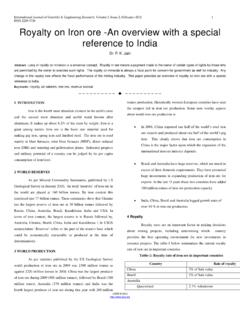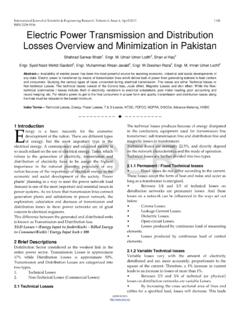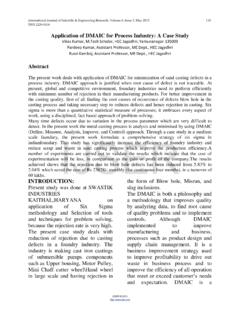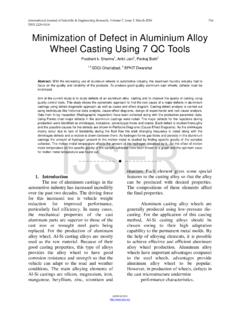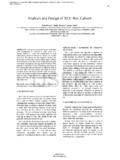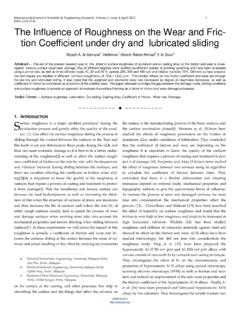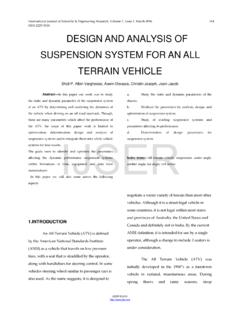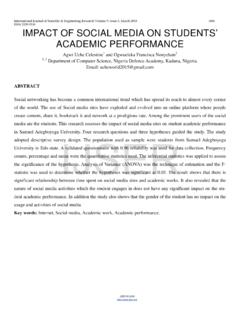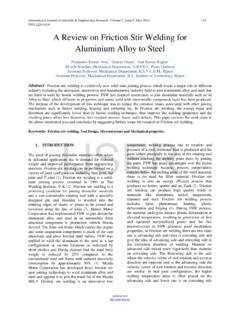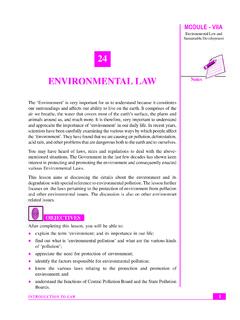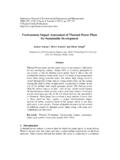Transcription of Impact of Solid Waste on Human Health: A Case ... - IJSER
1 International Journal of Scientific &Engineering Research Volume 4, Issue 11, November- 2013 ISSN 2229-5518 Impact of Solid Waste on Human Health: A Case Study of Varanasi CityPragya SinghDeptt. of Geography, H. N. (A Central University), Srinagar-Garhwal, Uttarakhand,IndiaAbstract Urbanization and population growth are solely responsible for high increasing rate of Solid Waste and its proper management is a major problem of Municipal Corporation. In this study, the sources and components of Solid Waste were identified; type and the quantity of Solid Waste disposed, methods of Solid Waste disposal and Impact of improper Waste management on health were highlighted. The result shows that excreta and other liquid and Solid Waste from households and the community, are a serious health hazard and lead to the spread of infectious : Remote Sensing & GIS, Solid Waste , Health, Disease - - - - - - - - - - - - - - - - - IntroductionThere are potential risks to Human health from improper handling of Solid wastes.
2 Direct health risks concern mainly the workers in this field, who need to be protected, as far as possible, from contact with wastes. There are also specific risks in handling wastes from hospitals and clinics. For the general public, the main risks to health are indirect and arise from the breeding of disease vectors, primarily flies and hazardous wastes from industries mixing up with municipal wastes create potential risks to Human health. Traffic accidents can result from toxic spilled wastes. There is specific danger of concentration of heavy metals in the food chain, a problem that illustrates the relationship between municipal Solid wastes and liquid industrial effluents containing heavy metals discharged to a drainage/sewerage system and /or open dumping sites of municipal Solid wastes and the wastes discharged thereby maintains a vicious cycle.
3 These are number of point by which Solid Waste may be come in contact with living organism such as: Soil absorption, storage and biodegrading Plan uptake Ventilation Leaching Insects, birds, rats, flies and animals Direct dumping of untreated Waste in seas, rivers and lakes result in the plants and animals that feed on itDue to municipal Solid wastes and the wastes discharged thereby maintains a vicious cycle including these some other types of problem are as follows: Chemical poisoning through chemical inhalation Uncollected Waste can obstruct the storm water runoff resulting in flood Low birth weight Cancer Congenital malformations Neurological disease Nausea and vomiting Mercury toxicity from eating fish with high levels of mercury Plastic found in oceans ingested by birds Resulted in high algal population in rivers and sea. Degrades water and soil qualityImproper MSW disposal and management causes all types of pollution : air, soil, and water.
4 Indiscriminate dumping of wastes contaminates surface and ground water supplies. In urban areas, MSW clogs drains, creating stagnant water for insect breeding and floods during rainy seasons. Uncontrolled burning of MSW and improper incineration contributes significantly to urban air pollution . Greenhouse gases are generated from the decomposition of organic wastes in landfills, and untreated leachate pollutes surrounding soil and water bodies. Health and safety issues also arise from improper MSWM. Insect and rodent vectors are attracted to the Waste and can spread diseases such as cholera and dengue fever. Using water polluted by MSW for bathing, food irrigation and drinking water can also expose individuals to disease organisms and other contaminants. The Public Health Service identified 22 Human diseases that are linked to improper MSWM.
5 Waste worker and pickers in developing countries are seldom protected from direct contact and injury, and the co-disposal of hazardous and medical wastes with MSW poses serious health threat. Exhaust fumes from Waste collection vehicles, dust stemming from disposal practices and the open burning of Waste also contribute to overall health problems. People know that poor sanitation affects their health, especially in developing and low-income countries, where the people are the most willing to pay for environmental improvements (Rathi, 2006; Sharholy et al, 2005; Ray et al., 2005; Jha et al., 2003; Kansal, 2002; UDSU, 1999; Kansal et al., 1998; Singh et al., 1998; Gupta et al., 1998;Objectives of the Study The main aim of this study is find out the various diseases due to Solid Waste in the study Area1840 IJSERIJSER 2013 International Journal of Scientific &Engineering Research Volume 4, Issue 11, November- 2013 ISSN 2229-5518 Varanasi as a city is situated on the left bank of Ganga river in broad crescent shaped.)
6 The urban agglomeration of Varanasi city stretched between 82 56 E - 83 03 E and 25 14 N - 25 N. The "Varanasi Urban Agglomeration" an agglomeration of seven urban sub-units covers an area of km 2 . It is situated on the left part of the Ganga, where the latter forcer a gigantic bow . The north ward flow of river imparts religious significance to the place. A relatively higher concave bank in the form of levees from Assi nala in the south to Varuna in north provides a dry points location skirting the Ganga. Presently the city is expanding towards Sarnath the Ghazipur road in the north east, towards Shivpur along the Jaunpur road in the north west, towards BHU in the south west and towards Diesel Locomotive Work (DLW) in the south-west. Rapid growth of population over the last two decades has rendered the central part of the city over crowded and too congested.
7 The City of Varanasi spreads over an area of sq km. According to census 2011 the total population of the city is 1597051. Location of the study area with land use /land cover map are shown in the fig. 1. Map of the Study AreaMaterial and Data used In order to fulfill the necessity of the study, following data were collected to perform objective of the study. Topographical DataSurvey of india (SOI) topographical map 63O/2, 63O/3, 63O/4, 63K/14, 63K/15. 63K/16 is used for the base map study on the scale of 1:50000. Satellite Data RESOURCE SAT-2 LISS-III Data (FCC)Satellite data of Indian Remote Sensing Satellite RESOURCE SAT-2/ ( resolution) acquired in 2012 was used for the Preparation of base-layer-Road/Railway/Transport network and Landuse/Landcover map of the study area . Primary data collection Data used Collateral/ Ancillary data from various state/central Govt. are various types of projections available in Arc GIS software for satellite data processing.
8 In the present study considers UTM projections WGS_84 datum. Geo-referencing of the image data of the study area is done in Arc-GIS Version the entire process of geo-referencing and SOI topographical sheet no. 63O/2, 63O/3, 63O/4, 63K/14, 63K/15. 63K/16 are used for the base map study on the scale of 1 order to achieve the objective database was collected from dump site s area years 2013 were used for the analysis for Impact of Solid Waste on health. The survey was carried out during the month of June to August 2013 of selected dump site s Mohalla of the study area. The survey questionnaire included queries of health status. Random sampling was done in dump site s area/Mohalla for a total of 200 samples and. The surveyed information was recorded into a database which was use to identified the favorable indicators of Impact of Solid Waste on health. Result and Discussion It performs a spatial statistical task such as different collections of data through personal survey of information about health factors.
9 Solid Waste required for the malaria, filarial, dengue and typhoid. Data base generated for the malaria, filarial and typhoid by the primary survey from the required dump sites and the data for dengue, collected from the department of health (CMO, Varanasi). Distribution of the disease and number of Human affected found during the primary survey for health status from the year 2013 shows in Table 1 & of Diseases due to SW in Varanasi city dump site s area( Month-June to Aug, 2013)Name of Area/Dump siteMalaria( Effected Person)Filaria ( Effected Person)Typhoid( Effected Person)Aurangabad15-11 Badi Gaibi17213 Nagwa Police Chowki site1038 Beniabagh13-101841 IJSERIJSER 2013 International Journal of Scientific &Engineering Research Volume 4, Issue 11, November- 2013 ISSN 2229-5518 Total55542 Source : personal survey Table 2 Report of Disease (Dengue) due to SW in Varanasi city ( Month-June to Aug, 2013)Month/Year 2013 Dengue ( Effected Person)June-July & August61 Source.
10 Health Deptt,Varanasi (CMO, Varanasi) In above mentioned table a total of 55 cases of Malaria, 5 cases of filarial and 42 cases of typhoid identified in the above area and 61 cases of dengue were found in Varanasi city in month of July and August 2013. Analyzing the disease incidence data, it is observed that the maximum case of dengue and the minimum case of filaria were recorded in study area. Dengue viruses have been recognized in recent decades as one of the most dreadful diseases worldwide. Dengue fever is a life threatening disease, if a person is being infected more than once because of poor management of Solid Waste , sanitation condition and condition of available ponds are not very much adequate. ConclusionThe focus of the study was on Impact of Solid Waste due to non engineering and non scientific disposal.
